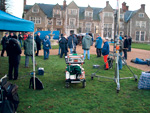Country house film locations
With the requisite patience and willingness, renting your house out to film and advertising production companies is a lucrative way to make more money from your property


Chatsworth, Castle Howard and Alnwick Castle are only a few of the country houses that have profited considerably from moonlighting as locations for film and television production companies. With the requisite patience and willingness, it's a win-win option for country-house owners: not only can the fees be substantial enough to tackle a reroofing project, but if you are open to the public, there are considerable long-term benefits. The coffers of Alnwick, for example, are currently benefiting from a 120% increase in visitors since the house doubled up as Hogwarts in the 'Harry Potter' films. However, not everyone can offer up a Vanbrugh backdrop, nor are they geared to catering for an invasion of more than 100 strangers, dozens of cars and all the assorted equipment scattered over the lawn. But all is not lost. 'Producers are looking for all manner of properties,' says Sarah Eastel, who runs a location company representing houses nationwide. 'At the very least, the main criteria are that they have to be photogenic and have large interiors (rooms of 20ft or more to accommodate the cast and crew).' Once, it was imperative to be within the M25 in order to attract the attention of a shoot, but the growth of regional companies has meant that this is no longer essential. 'But there are other location factors to take into account,' explains Miss Eastel. 'Flight paths are a no-no, and it's important to think of the neighbours. No one wants to be within sleep-disturbing distance of a music-video production team's playback at 2am.' Rarely a day goes by when she isn't called by a locations manager who is looking for a property with eight to 10 bedrooms. John Glare's 13th-century manor house in Dorset has proved especially successful due to the fact that the house came with a former police training-college building in the gardens. 'We can sleep and feed about 50 people on site,' says Mr Glare. 'So there's no need for the team to be billeted in pubs and hotels.' Forecasting income generation in this game is impossible: it's a hit-and-miss industry. A lot pivots on flexibility, and on-the-day call-ups are not unknown. Commissions can range from photo shoots for magazines and newspapers that last no more than a day to television commercials, dramas, reality programmes and feature films. Each has a separate price tag attached. As a rough guide, one should expect about £500 per day for a photo shoot, rising to £3,000 per day for a feature film. When a film production company commandeers a property for a 25-day shoot, the potential benefit is a cheque for £75,000. Signing up with a locations agency is a good idea, not only because they can negotiate the fees on your behalf, but also because they can vet the content of the programme and script. 'Everyone takes a different approach,' says Miss Eastell. 'I once had a company who wanted to use a house for a children's programme. But when I rang up the owner, she said no. "Darling, I'll have Playboy shoots in my house, but I won't have children."' Michael More-Molyneux and his wife are well versed in the art of being invaded by production companies, as their house, Loseley Park, has been used for many films and dramas, from Sense and Sensibility to Midsomer Murders via Spice World. 'My wife and I spend time babysitting the crews when they're on set and the mobile phone never stops ringing, but if you're willing to accept the disruption, it works very well,' says Mr More-Molyneux. 'And it helps to keep the slates on the roof. 'Furniture designer Jennifer Newman has an equally cheerful take on the experience, albeit on a smaller scale. 'I registered my L-shaped barn near Warminster two years ago, and it took until now to get a booking. The production company said they were looking for a Grand Designs-type property and mine seemed to suit. When they were here, I just decamped to a corner and carried on working. They were respectful and nothing was broken. It was all bonus, bonus, bonus.' The Historic Houses Association (HHA) has been dishing out advice on tapping into the film-location market for years. Its guide, Film and Photography for Historic Houses and Gardens, covers the minutiae of negotiations and considerations. The HHA's technical advisor Robert Parker can ensure that novices take advantage of all that's on offer. 'You must be clear from the start about cuts you will receive from any merchandising material they produce. If your property is clearly visible in any reproductions, then you should benefit.'
Exquisite houses, the beauty of Nature, and how to get the most from your life, straight to your inbox.

